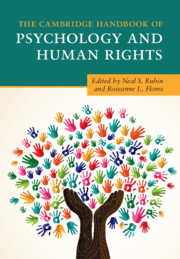Book contents
- The Cambridge Handbook of Psychology and Human Rights
- The Cambridge Handbook of Psychology and Human Rights
- Copyright page
- Dedication
- Contents
- Figures
- Tables
- Boxes
- Contributors
- Acknowledgments
- The Core International Human Rights Instruments and Their Monitoring Bodies
- Universal Human Rights Instruments
- Sustainable Development Goals
- Glossary of United Nations and Psychology Acronyms in the Handbook
- Introduction
- Part I History of Human Rights
- 1 How Fear and Hope Shaped the Universal Declaration of Human Rights
- 2 Human Rights Developments from the Universal Declaration to the Present
- 3 Connecting Human Rights and Psychological Ethics in a Globalizing World
- 4 A Historical Narrative of Psychology Engaging Human Rights within the Framework of the United Nations
- Part II The Intersection of Psychology and Human Rights
- Part III Contemporary Issues in Psychology and Human Rights
- Part IV Teaching, Research, and Training in Psychology and Human Rights
- Part V Future Directions
- Index
- References
4 - A Historical Narrative of Psychology Engaging Human Rights within the Framework of the United Nations
from Part I - History of Human Rights
Published online by Cambridge University Press: 02 October 2020
- The Cambridge Handbook of Psychology and Human Rights
- The Cambridge Handbook of Psychology and Human Rights
- Copyright page
- Dedication
- Contents
- Figures
- Tables
- Boxes
- Contributors
- Acknowledgments
- The Core International Human Rights Instruments and Their Monitoring Bodies
- Universal Human Rights Instruments
- Sustainable Development Goals
- Glossary of United Nations and Psychology Acronyms in the Handbook
- Introduction
- Part I History of Human Rights
- 1 How Fear and Hope Shaped the Universal Declaration of Human Rights
- 2 Human Rights Developments from the Universal Declaration to the Present
- 3 Connecting Human Rights and Psychological Ethics in a Globalizing World
- 4 A Historical Narrative of Psychology Engaging Human Rights within the Framework of the United Nations
- Part II The Intersection of Psychology and Human Rights
- Part III Contemporary Issues in Psychology and Human Rights
- Part IV Teaching, Research, and Training in Psychology and Human Rights
- Part V Future Directions
- Index
- References
Summary
Human rights are a pillar of the United Nations that emerged as a formative principle of that body in 1945 and that are evident in the Universal Declaration of Human Rights (adopted in 1948) and other subsequent major international instruments affirming the dignity and equality of all. While the United Nations is primarily a stage for member governments to make agreements, non-governmental organizations (NGOs), including those comprised of psychologists, can be accredited by two bodies, namely the Economic and Social Council and the Department of Global Communications, to advocate on behalf of their issues. This chapter presents a historical narrative of more than seventy years of engagement by psychologists who represent such NGOs on issues of human rights and social justice. Five sections cover individual psychologists who pioneered interactions with the United Nations; the varied activities and contexts in which psychologists interact with UN bodies; contributions of selected psychology organizations at the United Nations that have been active in the protection and advancement of human rights; new ways psychologists are collaborating in human rights efforts at the United Nations; and challenges and the way forward for such professionals in their contributions to human rights on the world stage.
Keywords
- Type
- Chapter
- Information
- The Cambridge Handbook of Psychology and Human Rights , pp. 56 - 72Publisher: Cambridge University PressPrint publication year: 2020
References
- 2
- Cited by

